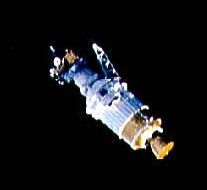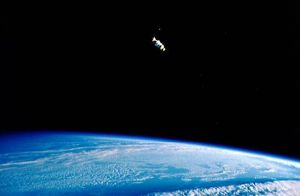
Home - Search - Browse - Alphabetic Index: 0- 1- 2- 3- 4- 5- 6- 7- 8- 9
A- B- C- D- E- F- G- H- I- J- K- L- M- N- O- P- Q- R- S- T- U- V- W- X- Y- Z
Ulysses
 Ulysses Credit: NASA |
Status: Operational 1990. First Launch: 1990-10-06. Last Launch: 1990-10-06. Number: 1 . Gross mass: 367 kg (809 lb). Height: 3.00 m (9.80 ft).
The spacecraft was placed by a Titan 3E booster on a trajectory that intercepted Jupiter and used the giant planet's gravity to torque the orbit into one far beyond the solar system's ecliptic plane. Ulysses' first pass above the Sun's southern pole was completed in November 1994, and its first pass above the northern pole was completed in October 1995, ending the primary mission. The mission was subsequently extended to permit further observations.
Originally named the International Solar Polar Mission, Ulysses' primary scientific objectives were to investigate, as a function of solar latitude, the properties of the solar corona, the solar wind, the structure of the Sun-wind interaction, the heliospheric magnetic field, solar and non-solar cosmic rays, solar radio bursts and plasma waves, solar x-rays, and interstellar / interplanetary neutral gas and dust.
The spacecraft was spin stabilized at 5 rpm (Earth pointing). X-, and S- band communications used a 1.65 m high gain antenna. Radioisotope thermal generators were used for power generation, and provided 285 W (BOL). A hydrazine propulsion provided for trajectory correction maneuvers. Redundant tape recorders stored 46 Mb each. Three deployable booms were used for science instruments.
Ulysses carried 9 instruments in addition to using the radio system for scientific investigations. Total payload mass was 55 kg. The experiments included:
- Magnetometer (VHM/FGM) - designed to measure changes in the interplanetary magnetic field at different heliographic latitudes
- Solar Wind Plasma Experiment (SWOOPS) - studied protons, electrons and heavy ions in the solar wind and their dependence on distance from the Sun and heliospheric latitude
- Solar Wind Ion Composition Instrument (SWICS) - studied the elemental and ionic-charge composition, and the mean temperatures and mean speeds of all solar-wind ions from hydrogen to iron
- Unified Radio and Plasma Wave Instrument (URAP) - designed to determine the direction and polarization of distant radio sources, as well as radio bursts from charged particles in the solar wind
- Energetic Particle Instrument (EPAC) - measured intensities and energies of interplanetary ions to resolve their masses and to observe helium penetrating the heliosphere from interstellar space
- Heliosphere Instrument for Spectral, Composition and Anisotropy at Low Energies (HISCALE) - designed to measure elemental abundances of interplanetary ions and electrons
- Cosmic Ray and Solar Particle Instrument (COSPIN) - resolved outstanding problems in solar, interplanetary and cosmic-ray physics for which observations far out of the ecliptic plane were required
- Solar X-Ray and Cosmic Gamma-Ray Burst Instrument (GRB) - measured electrons in solar flares and determined the direction of gamma-ray bursts from distant galaxies
- Cosmic Dust Experiment (CDE) - provided direct observations of particulate matter and its interaction with solar radiation as a function of ecliptic latitude.
NASA NSSDC Master Catalog Description
The primary objectives of Ulysses, formerly the International Solar Polar Mission (ISPM), are to investigate, as a function of solar latitude, the properties of the solar wind and the interplanetary magnetic field, of galactic cosmic rays and neutral interstellar gas, and to study energetic particle composition and acceleration. The 55 kg payload includes two magnetometers, two solar wind plasma instruments, a unified radio/plasma wave instrument, three energetic charged particle instruments, an interstellar neutral gas sensor, a solar X-ray/cosmic gamma-ray burst detector, and a cosmic dust sensor. The communications systems is also used to study the solar corona and to search for gravitational waves. Secondary objectives included interplanetary and planetary physics investigations during the initial Earth-Jupiter phase and investigations in the Jovian magnetosphere. The spacecraft used a Jupiter swingby in Feb. 1992 to transfer to a heliospheric orbit with high heliocentric inclination, and will pass over the rotational south pole of the sun in mid-1994 at 2 AU, and over the north pole in mid-1995. A second solar orbit will take Ulysses again over the south and north poles in years 2000 and 2001, respectively. The spacecraft is powered by a single radio-isotope generator. It is spin stabilized at a rate of 5 rpm and its high-gain antenna points continuously to the earth. A nutation anomaly after launch was controlled by CONSCAN. The original mission planned for two spacecraft, one built by ESA and the other by NASA. NASA cancelled its spacecraft in 1981.
More at: Ulysses.
| STS-61-F Planned shuttle mission for deployment of Ulysses spacecraft. Cancelled after Challenger disaster. |
| Ulysses European solar satellite. Ulysses was a joint NASA / ESA mission designed to study the polar regions of the Sun. Solar lander built by Dornier (prime) for ESA, NASA, Europe. Launched 1990. |
Family: Astronomy, Outer planets, Solar. Country: Europe. Launch Vehicles: Space Shuttle. Launch Sites: Cape Canaveral, Cape Canaveral LC39B. Agency: JPL, NASA, ESA, Dornier. Bibliography: 2, 279, 4187, 4188, 6.
 | Ulysses Credit: Manufacturer Image |
 | STS-41 Ulysses spacecraft and its upper stage system are deployed during STS-41 Credit: NASA |
 | STS-41 Ulysses spacecraft and its upper stage system are deployed during STS-41 Credit: NASA |
 | STS-41 Ulysses spacecraft and its upper stage system are deployed during STS-41 Credit: NASA |
1990 October 6 - . 11:47 GMT - . Launch Site: Cape Canaveral. Launch Complex: Cape Canaveral LC39B. Launch Platform: MLP2. LV Family: Shuttle. Launch Vehicle: Space Shuttle.
- Ulysses - .
Payload: Discovery F11 / Ulysses [IUS + PAM-S]. Mass: 367 kg (809 lb). Nation: USA.
Agency: JPL,
NASA.
Class: Astronomy.
Type: Solar satellite. Spacecraft: Ulysses.
USAF Sat Cat: 20842 . COSPAR: 1990-090B. Apogee: 300 km (180 mi). Perigee: 285 km (177 mi). Inclination: 28.40 deg. Period: 90.10 min.
Deployed from STS 41 10/6/90; solar research. Ulysses is a scientific spacecraft, within the framework of the international solar/polar mission. It will be the first spacecraft to fly over the poles of the sun. Frequency 2111.6073/2293.1481 MHz, 8408.2099 MHz., interplanetary trajectory i nto a polar flyby over the sun. Designator ESA/90/01. Also registered by the United States in ST/SG/SER.E/250, orbital data are taken from that document.
1992 February 8 - .
1994 November - .
- Ulysses' first pass above the Sun's southern pole completed - . Nation: International. Spacecraft: Ulysses.
1995 October - .
- Ulysses' first pass above the Sun's north pole completed - . Nation: International. Spacecraft: Ulysses. This ended the primary mission. The mission was subsequently extended to permit further observations..
2004 February 4 - .
Back to top of page
Home - Search - Browse - Alphabetic Index: 0- 1- 2- 3- 4- 5- 6- 7- 8- 9
A- B- C- D- E- F- G- H- I- J- K- L- M- N- O- P- Q- R- S- T- U- V- W- X- Y- Z
© 1997-2019 Mark Wade - Contact
© / Conditions for Use